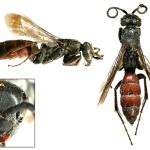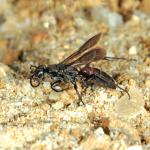This particularly distinctive member of our pompilid fauna is generally scarce, but it has been recorded widely in southern England. In Wales, it has been recorded from Bosherton, Dyfed, whilst on the Channel Islands it is known from Sark, Herm, Jersey and Guernsey.
Listed in Falk (1991) as Nationally Notable (Na).
Day, 1988 is the standard work for identifying British Pompilidae. Wiśniowski, B., 2009 is also useful.
The majority of modern records are coastal, with a suggestion of a decline inland which may be correlated to the widespread loss of inland habitat for the wasp's spider prey. On the coast, the habitat is typically cliffs and landslips, whilst inland, well-grazed downland and heathland are the usual haunt of both spider and wasp. In all these locations, south-facing slopes and banks in sunny locations are important.
Apparently single-brooded; June to early September.
Umbellifers such as wild carrot, wild parsnip and rock samphire.
1997



